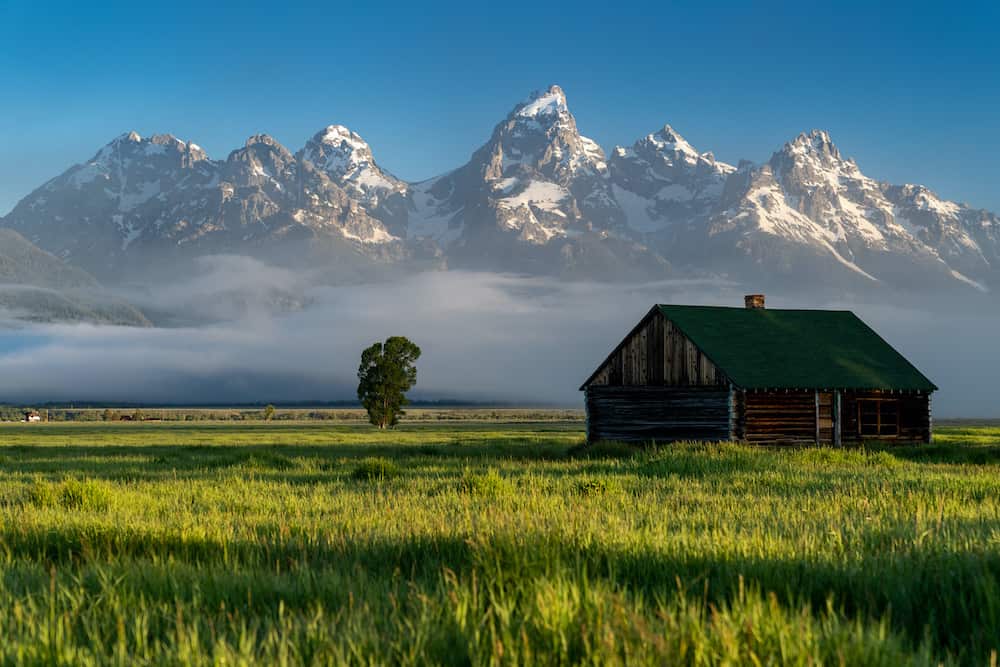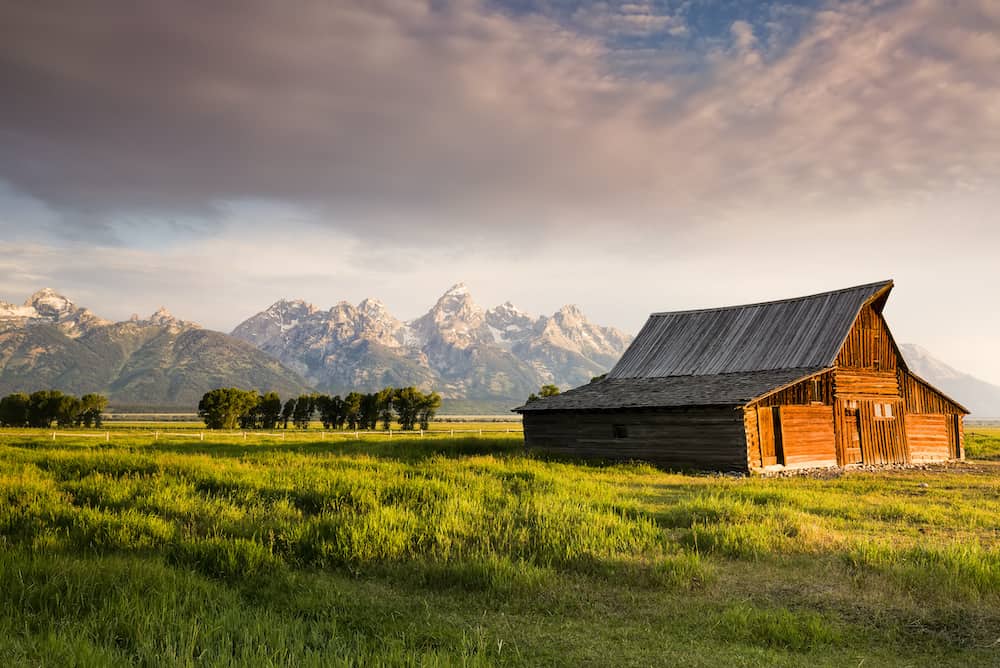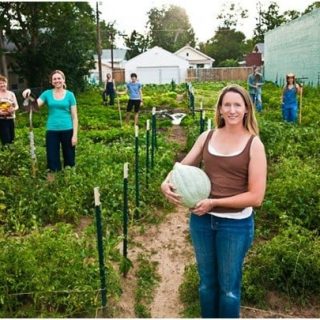Are you planning on making a lifestyle shift to one where you go off the grid? If so, it’s important to know the best states for homesteading. A change this big requires you to leave the conveniences of the suburban or urban life. However, living a life of self-sufficiency is possible in the best states for homesteading.
Once you find the right piece of land, you’ll be able to change the way you live by focusing on nature’s methods and tools. Whether you want to live off the grid or have a more modern homesteading life, there are plenty of options across the United States for experienced and beginning homesteaders.
Best States for Homesteading
Before settling on a place to live, first ask yourself, “What states allow homesteading?” Below, you’ll find the top five states to consider for planting your family’s roots.
What States Allow Homesteading?
Homesteading is allowed in all states; however, not every area is applicable. For example, in New York, there are specific boroughs where homesteading is permitted. Where the differences come into play are the exemptions per state and whether they have federal exemptions available or not.
It is also crucial for you to consider the benefits of homesteading in one state over another. For example, Arizona might have coverage for more of your belongings than Arkansas.
Tennessee
Tennessee is fantastic for homesteading, especially if you enjoy seasonal changes. With its mild and moderate climate, you’ll get all four seasons and have access to fertile land. Also, if you opt for more middle and western regions, you’ll find farming is particularly advantageous in these areas.
There are several picturesque landscapes for you to enjoy in Tennessee, too. More than that, you’ll have the added advantage of a low cost of living, which is approximately 10% less than the rest of the United States. To help boost homesteading in the state, Tennessee even hosts the Great Appalachian Homesteading Conference.
The main concern for new residents is that although you get four seasons, you also get natural disasters. This state is known for flooding, tornadoes, and inclement weather that you should be prepared for.
Homesteading Law in Tennessee
The homestead law in the state protects families from having to give the entirety of their property to creditors. This point comes into play if you experience financial hardships. For your property to be considered a homestead, it must be your primary residence. To help make your transition simpler, you can apply for the Rural Homesteading Land Grant.
There is also a homesteading exemption in the state of up to $5,000. Compared to other states, Tennessee has a competitive exemption program.
Idaho
Currently, there are over 60,000 homesteads in Idaho, making it one of the most popular places to settle. Not only will you be able to acquire land, but you will also have access to the incredibly fertile soil. There are different climates and ecosystems in Idaho, depending on where in the state you live. If natural disasters are a worry for you, Idaho rarely experiences any, apart from wildfires.
One of the most respected elements of the state is that there isn’t a shortage of outdoor activities. Your family will love maintaining your farm, skiing, whitewater rafting, and fishing.
The majority of residents are welcoming to homesteaders, as it is a lifestyle that most residents already participate in. It is possible to have plenty of privacy in Idaho, too, especially as some towns have low populations. Also, Idaho has a substantially lower crime rate than many other states that offer homestead possibilities.
Homesteading Law in Idaho
The homesteading laws in Idaho benefit homesteaders more than the government. You’ll find coverage for homeschooling, growing your crops, and even raising livestock. The homesteading law states explicitly that your permanent homestead will be protected in a financial crisis. In terms of protection from creditors, you can get up to $100,000, as long as you are the property owner.
You will also need to have a Declaration of a Homestead filed with the government. It’s important to note that even if you own a previous piece of property, new paperwork is required for each.
Also, only one of your residences may be declared in your Homestead Declaration.
Oregon
Oregon is a beautiful state, and it also offers plenty of opportunities for managing your farm. Families will easily be able to grow an assortment of crops and gardens and orchards with fertile lands for livestock.
Known for their exemplary farmer’s markets, you can even transition your homestead into a profitable venture. You’ll love being surrounded by beautiful mountainous regions that appear specifically designed to promote self-sufficient living.
Unlike other states, you won’t have to worry about living in a secluded area, as most homesteaders in Oregon have neighbors. There are entire homesteading towns, too, so that you can build connections and friendships with your neighbors.
Homesteading Law in Oregon
If you are married, you can receive exemptions of up to $50,000 in the state for homesteading. Single individuals, on the other hand, will receive up to $40,000.
It is also important to note that where you live can have a significant bearing on your coverage. Homesteaders who live outside of the city or town limits can protect up to 160 acres. Whereas, if you live within limits, you can cover up to one city block of your property.
Interestingly enough, you can also use the homestead exemption to protect the proceeds you receive from selling your homestead. There are regulations and rules about the exemptions to consider.

Missouri
With an ample growing season, homesteading in Missouri can be a beneficial experience. It has a pleasant climate with some extremes, although they’re not typical. You can expect the last spring frost between the middle of April and the beginning of May.
If you’re in the land market, Missouri is one of the best states to consider, as their plots are large. According to the United States Department of Agriculture, the average size of Missouri farms in 2019 was 290 acres.
The hardiness zones for the majority of the state fall within zones five, six, and seven. Farmers will easily be able to grow an assortment of carrots, Brussels sprouts, cabbage, collard greens, peas, and potatoes.
Similar to Oregon, there are plenty of farmer’s markets where you can sell your vegetables. U-pick farms are also booming in popularity, as well as farmers selling their produce to small restaurants and eateries.
Farming and homesteading bring up to $88.4 billion to Missouri annually, making it a highly favorable option.
Homesteading Law in Missouri
Missouri offers a $15,000 exemption for homesteaders, as long as the home you’re declaring is your permanent residence. Within the statute, it is evident that the total exemption cannot be more, even if there are two co-owners.
Another aspect of the homesteading law in Missouri is that a co-owner may not sell the property if the other owner claims homestead protection. Before you are allowed to declare your settlement as a homestead, you must be living on the land for 40 consecutive months.
Michigan
If you’ve been interested in brushing up on your greenhouse gardening, Michigan is a great opportunity. Located in the Great Lakes region of the United States, it’s very agriculturally diverse. As a bonus, if you start a farm, you will be protected by the “right to farm” laws. Michigan ensures farmers are protected from nuisance complaints from neighbors, as long as you are performing approved agricultural practices.
There are over 47,000 farms in Michigan, ranging from one to 209 acres, depending on the crop and livestock. With an average growing season of 140 days, you’ll manage tomatoes, pumpkins, peppers, and beans, to name a few.
The majority of the state falls within hardiness zones four, five, and six. However, you might also want to consider greenhouse equipment, as Michigan is prone to inclement weather.
They surely have warm summers and springs, but their winters can be frigid. With a greenhouse setting, you can ensure your homestead is profitable year-round.
Homesteading Law in Michigan
One of the essential laws in Michigan about homesteading is how you keep your livestock. They must be in secured pastures with adequate shelter to exhibit good farming practices.
As for the state’s homesteading law, you can allocate up to 40 acres of rural land to be a homestead. If you’re more interested in metropolitan homesteading, you can mandate up to $3,500 worth of urban land to be your homestead.
If you are approached with financial hardship, Michigan protects homesteaders in specific ways. For example, the state prohibits creditors from seizing the following:
- Money or benefits from particular disability and insurance policies
- Trade tools (up to $1,000)
- Household goods (not exceeding $1,000)
What States Offer Free Land?
The concept of getting free land might sound unbelievable, especially in today’s day and age. However, thanks to the Homestead Act of 1862, families can still receive free land, as long as you meet specific guidelines.
There are plenty of states that offer free property, although the majority do so in small towns to boost population rates. If you’re wondering what states offer free land, a few examples include:
- Kansas
- Texas
- Colorado
- Missouri
- Nebraska
- Minnesota
- Iowa
- Maine
- New York
- Ohio
Narrowing your search to a state which offers free land can be a good place to start when you are relocating to homestead.
Can You Still Use the Homestead Act?
Unfortunately, no, the Homestead Act was eliminated in 1976. Most homesteading occurred between 1863 and 1900, with it coming to an end near the early 1930s. Although the Homestead Act no longer exists, you can still find plenty of free lands.
What Is the Cheapest State to Buy Land?
If you have a specific part of the state that you want to live in, free land might not be an option. Most states will provide free land in particular areas to boost the economy and population throughout the state.
Nonetheless, just because you can’t get free land doesn’t mean that you won’t find cheap land.
If you are searching for affordable land, make your deep research or ask for advice from the industry professionals. In any case, keep in mind that location is the key factor that influences the price. Consider that cheap doesn’t always need to be low quality.
Everything depends on what you are exactly searching for. Try to formulate the basic requirements that you expect from the land, this will make the choice more structured and easier.
For example, try to understand whether you are searching an area that is close to nature and is more isolated or the area that has a saturated population and expanded job markets.
So, try to come up with your own list. When you have an idea what you’re searching for it’ll be more than possible to find the perfect match of price and quality ratio if you are searching in the right area.
The following states are highly recommended for inexpensive land prices:
1. Tennessee
Tennessee is particularly attractive because it doesn’t have a state income tax but has a low cost of living. It also has some of the least expensive land available; some plots can go as low as $0.37 per square foot.
On average, you can expect to buy a 251,911 square foot lot for as little as $59,408. As an added benefit, the state is quite large, so you are bound to find numerous inexpensive lots. Still, if you want to move to Tennessee, it’s best to do so quickly. The population is increasing drastically as the years go on.
Tennessee has continued to grow since PC 1101’s passage, although some areas are growing much faster than others. The amount of developed land in Tennessee increased 18% from 1997 to 2012, according to the National Resources Inventory of 2012.
The counties surrounding Metropolitan Nashville-Davidson County are the fastest growing areas in Tennessee. The Nashville Area Metropolitan Planning Organization, which is the regional transportation planning agency for seven counties, estimates an additional one million people will live in the area by 2035.
2. Arizona
Apart from its hot summers in much of the state, Arizona is also known to be a highly popular tourist destination. If you’re interested in buying land in the state, you could pay less than you would think. On average, a 91,088 square foot lot can run you $45,420.
3. Florida
There are plenty of things to find in Florida, from famous attractions to miles of beaches. You’ll even find charming neighborhoods spanning from Orlando to Sarasota. Fortunately, it is also an incredibly affordable place to buy land, though the ritzier the neighborhood, the more expensive it is. For example, land in Winter Park is bound to be substantially more expensive than in Tampa Bay. On average, some plots can be as low as $0.16 per square foot.
4. Arkansas
For homesteaders searching for the cheapest state to buy land, we highly recommend Arkansas. It offers plenty of outdoor activities, highly fertile soil for farming, and is perfect for nature lovers. Also, it is incredibly diverse, with country-friendly and urban dwellings depending on where you live. Above all else, it has a low cost of living, and a booming economy makes it a fantastic investment.
The cheapest land available in Arkansas can be found near Clay County for approximately $0.07 per square foot. However, prices across the state are quite competitive.

What State Is Best for Off Grid Living?
There’s a lot to consider when living off the grid, especially if you want your life to be comfortable. You’ll need to consider climate and weather first and foremost, as they can affect everything, even alternative power. You’ll want to start by learning about what off grid living and surviving outdoors entails along with realistic off grid power sources such as solar and other methods.
From the soil’s quality to how much sun you get per day, finding the ideal place to live away from society is challenging. It will be important to learn about the rainfall in the area and rainwater collection. There are many things to love about rural living but it’s not without its challenges.
When trying to answer what state is best for off grid living, among the things to consider are land prices, property taxes, and land quality.
To give you an idea, here’s a list of the top choices:
1. Maine
Both the state laws and zoning requirements work in favor of off-the-grid searchers in Maine. You’ll also appreciate the bonus of remote areas, inexpensive land options, and a low population density.
With plenty of access to natural resources, you’ll find rock, timber, and water are always in abundance. Even though they don’t have the most impressive growing season, you can easily use greenhouses.
2. Montana
For people who enjoy cold and warm weather, Montana is an exciting location to consider. You can guarantee that population density is one of its least significant issues. Also, their laws are beneficial for people who are interested in living self-sufficiently. With low crime rates and a low cost of living, finding land in the state is easy.
Although the growing season in Montana is short, it’s one of the best locations for raising livestock.
3. Tennessee
Clearly one of the best states for homesteading, Tennessee is another fantastic option for off-the-grid living. There are plenty of resources for people who want to live away from densely populated areas. Also, rural living is incredibly friendly to small budgets, especially in terms of land prices.
Tennessee also has a far better growing season than the other states we’ve mentioned. You can grow crops up to 260 days per year thanks to its moderate climate.
Best Homesteading States
Like any other big change, switching from urban living to homesteading is never easy. Leaving the city for land, homesteading and more takes planning and depends on the right opportunity at the right time.
What’s more, if you’re wondering if can you still use the Homestead Act, you’d find that the original no longer applies. Nevertheless, there are plenty of exceptional states that offer homesteading land and inexpensive land.
So, whether you want to live off-grid or are ready to start your own farm in a rural town, embracing the homesteading lifestyle is possible. The key is to know how and where to start.

How to Find the Best States for Homesteader
What is Homesteading
So you want to be a homesteader? If so, it's important to know the best states for homesteading. A change this big requires you to leave the conveniences of the suburban or urban life. However, living a life of self-sufficiency is possible once you find the right piece of land, you'll be able to change the way you live. Whether you want to live off the grid or have a more modern homesteading life, there are plenty of options across the United States for experienced and beginning homesteaders.
Instructions
What States Allow Homesteading?
- Tennessee
- Idaho
- Oregon
- Missouri
- Michigan
- Alaska
What States Offer Free Land?
- Kansas
- Texas
- Colorado
- Missouri
- Nebraska
- Minnesota
- Iowa
- Maine
- New York
- Ohio
What Is the Cheapest State to Buy Land?
- Tennessee
- Arizona
- Florida
- Arkansas
- New Mexico
What State Is Best for Off Grid Living?
- Maine
- Montana
- Tennessee
- Alaska
Notes
Homesteaders of America
Like any other big change, switching from urban living to homesteader is never easy. What’s more, if you’re wondering if can you still use the Homestead Act, you’d find that the original no longer applies. Nevertheless, there are plenty of exceptional states that offer homesteading land and inexpensive land.
So, whether you want to live off-grid or are ready to start your own farm in a rural town, embracing the homesteading lifestyle is possible. The key is to know how and where to start.
Related Posts:
- Living or Just Existing
- Best rural places to live ~ Best Places to Live in USA ~ Best rural places to live
- Escape to the country ~ Start of the journey
- How to Escape to the country and Live the Lifestyle You Want
- Homesteading today for self sufficient organic lifestyle
- Essential DIY skills homesteader
- Affordably building living off of the grid

